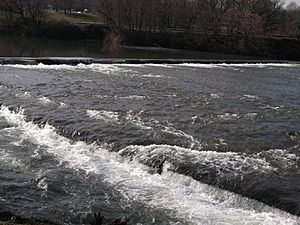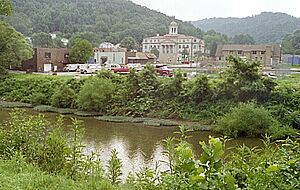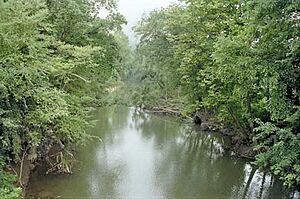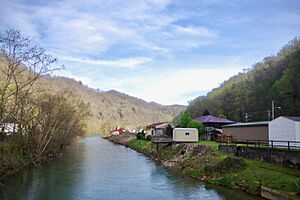Coal River (West Virginia) facts for kids




The Coal River is a river in southern West Virginia. It flows into the Kanawha River. The Coal River starts near Alum Creek. This is where the Big Coal River and Little Coal River join together. The river then flows north through Kanawha County. It passes Upper Falls and ends at St. Albans.
Contents
History of the Coal River
How the River Got Its Name
The Delaware Indians first called this river Walhondecepe. In the 1700s, an explorer named John Peter Salling renamed it. He called it the Coal River because he found lots of coal along its banks. The Big, Little, and main Coal Rivers are all part of the Coal River Watershed.
Early Uses of the River
For a long time, these rivers were very important for travel. Native Americans used them for hunting and fishing. Early settlers found coal along the Big Coal River. This coal was great for heat and light. People also used the rivers to float cut timber down to the Kanawha Valley.
Coal Mining and Transport
In the mid-1800s, a special type of coal called Cannel Coal was found. This coal could make a valuable coal oil. This oil was used for lighting, replacing whale oil. It burned brightly and made little smoke.
To help move the coal, a system of locks and dams was built. This system was 34 miles long. It was designed by William Rosecrans in 1851. The Coal River Navigation Company spent about $208,000 to build it.
The lock and dam system worked well from 1855 to 1861. In 1860, over 850,000 bushels of coal were shipped. The American Civil War stopped the operations. But after the war, a new company rebuilt the system. It was used again until 1881. In total, the system operated for 16 years.
Today, the old locks, dams, and log booms are on the National Register of Historic Places. Log booms were built after floods washed away parts of the lock system. They helped guide cut timber to sawmills near St. Albans. The Coal River from St. Albans to Upper Falls is still a recognized navigable waterway.
Other Industries and the Railway
Around 1800, mills were built along the river. These were flax mills and gristmills. Flax mills made fiber for textiles (cloth). Gristmills made flour and cornmeal.
Later, the Coal River and Western Railway Company started train service. This happened in the early 1900s. The railway provided a reliable way to move coal and timber. This helped the local economy grow a lot.
Environmental Concerns
Mining and Water Quality
The Coal River area has a lot of coal mining. This includes underground and surface mining. A byproduct of coal mining is Coal slurry impoundments. These are ponds that hold waste from coal preparation. This waste can contain harmful substances. These include heavy metals like arsenic, cadmium, lead, and mercury. There is concern about a repeat of a past disaster, like the Buffalo Creek flood.
Working Towards a Healthier River
Many local volunteer groups are working to help the river. They want to make it a better home for fish. They also want to create more chances for fun activities. The West Virginia Department of Environmental Protection is also helping. They have a program to restore the Little Coal River. They are building structures to move built-up silt. This helps improve fish habitats. Marshall University is also studying the river's water quality.
Big Coal River
The Big Coal River starts in Raleigh County. It begins as two streams: the Clear Fork and the Marsh Fork. These streams join near Whitesville. The river then flows northwest through Boone County. It passes towns like Sylvester, Seth, and Racine.
Little Coal River
The Little Coal River also starts as two streams. The Spruce Fork is in Logan County. The Pond Fork is in Boone County. They meet at Madison in Boone County. The river then flows north, past towns like Danville and Julian.
Tour de Coal
The Tour de Coal is a fun "paddling event" for canoes and kayaks. It usually happens in June. The trip is 11 miles long, from Upper Falls to St. Albans. Paddlers go through the Lower Falls, which is a one-mile rapid. About 200 people took part in 2009.

